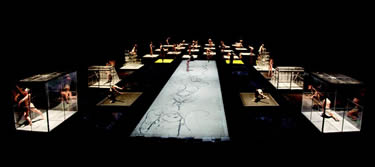The second concert of the Four Seasons Chamber Music Festival‘s 15th anniversary season featured five veteran guest performers who joined their host for the first time on the same stage in a spectacular program of string sextets. Artistic director and festival founder Ara Gregorian invited players who have appeared with him several times before over the years – but never all at once – to perform Johannes Brahms’ two string sextets and a scaled-down arrangement of Edward Elgar’s Serenade for Strings. The concert was a special treat from beginning to end, two or three programs’ worth of music at one sitting.
The sextet players consisted of Hagai Shaham and Xiao-Dong Wang (a member of Concertante), violins, Gregorian and Ida Kavafian, violas, and Colin Carr and Zvi Plesser, cellos. And with the way Brahms scored his music, these six performers sounded at times like a string orchestra of many more players. Furthermore, the musicians gave evidence to those in the audience of truly enjoying themselves while playing this music with each other.
One would be hard-pressed to pick a favorite on the program, but the performance of Brahms’ Sextet No. 1 in B-flat, Op. 18, might win the prize. Played with passion, energy, sensitivity, and great musical skill, this sextet by the 27-year-old Brahms seemed to be one glorious musical passage after another, for more than 30 minutes. From the opening Allegro ma non troppo to the closing Rondo: poco allegretto e grazioso, this piece encompassed just about everything one hopes for in a chamber music composition – bold and energetic passages, quiet and nuanced passages, interesting phrases played by pairs or trios or quartets, subtle emotions, and full-blown thrills. At times, one could almost imagine how this sextet would sound if played by a full orchestra, but in the end, the scoring for six string players was just right, and these six players were terrific.
Deserving special mention in this sextet is the Andante, ma moderato, movement, a lovely theme-and-variations that let the entire ensemble, small ensembles within the group, and individual players take the spotlight. The Scherzo: allegro molto third movement contains contrasting dance-like figures that shift from formal to folk, and the final movement, which opens with such a lovely melody led by the cellos, included a dazzling (and furious) closing by Kavafian that just about left the audience breathless.
The Sextet No. 2 in G, Op. 36, was Brahms’ way of ending his engagement to Agathe Siebold, and the tone of this composition leans more toward the romantic side of the composer. One notices an interesting musical technique throughout the opening Allegro non troppo movement: the gentle rocking of the bow across the strings, known as a bariolage, sort of an undulating musical voice that suggests the murmuring of sweet nothings, or perhaps sweet somethings, in the ear. Gregorian opened the movement with this technique, for example, with the actual melody played by first violinist Shaham. The violins also used the technique in passages played under the cellos. The Scherzo-allegro non troppo-presto giocoso second movement included some fugue-like passages and an interesting trio of first and second violin plus viola playing over plucked cellos and second viola. Although labeled a scherzo, the movement starts softly, and the scherzo’s liveliness doesn’t kick in until later.
The players offered a lovely reading to the elegant Adagio third movement, with its unBrahmsian, almost ghostly, figure played by Carr, and the lively Poco allegro closing movement included additional “interior” trio passages that seem to be a hallmark of both sextets.
The opening selection on the program was Gregorian’s arrangement of the Serenade for Strings in E-minor, Op. 20, by Elgar, certainly one of the composer’s most beautiful works. The festival’s Next Generation concert in October included this piece played by a chamber orchestra; the recent concert offered a more intimate, less lushly-scored version that was every bit as satisfying.
First violinist Wang provided a beautiful singing tone in the opening Allegro piacevole movement and Larghetto second movement, and Shaham had lovely descant-type lines in the second movement. The melancholy of the second movement gave way to more lightness in the Allegretto third movement, and the musicians conveyed this lightness quite nicely. If one had a complaint about this piece, it would not be directed at the players, who were so good, but at the composer, who should have written a longer work, especially the first and final movements, both of which end way too soon. It almost seems as if Elgar might have been distracted by something back in 1892, so he cut the opening movement, put a quick end to the final movement and directed his attention elsewhere.
Nevertheless, this was a concert to savor. One does not often get a chance to hear a string sextet of this caliber, and although they had come together only a few days before, this sextet delivered music of the highest quality.
This program will be repeated on Nov. 14 in the same venue. For details, see the sidebar.











